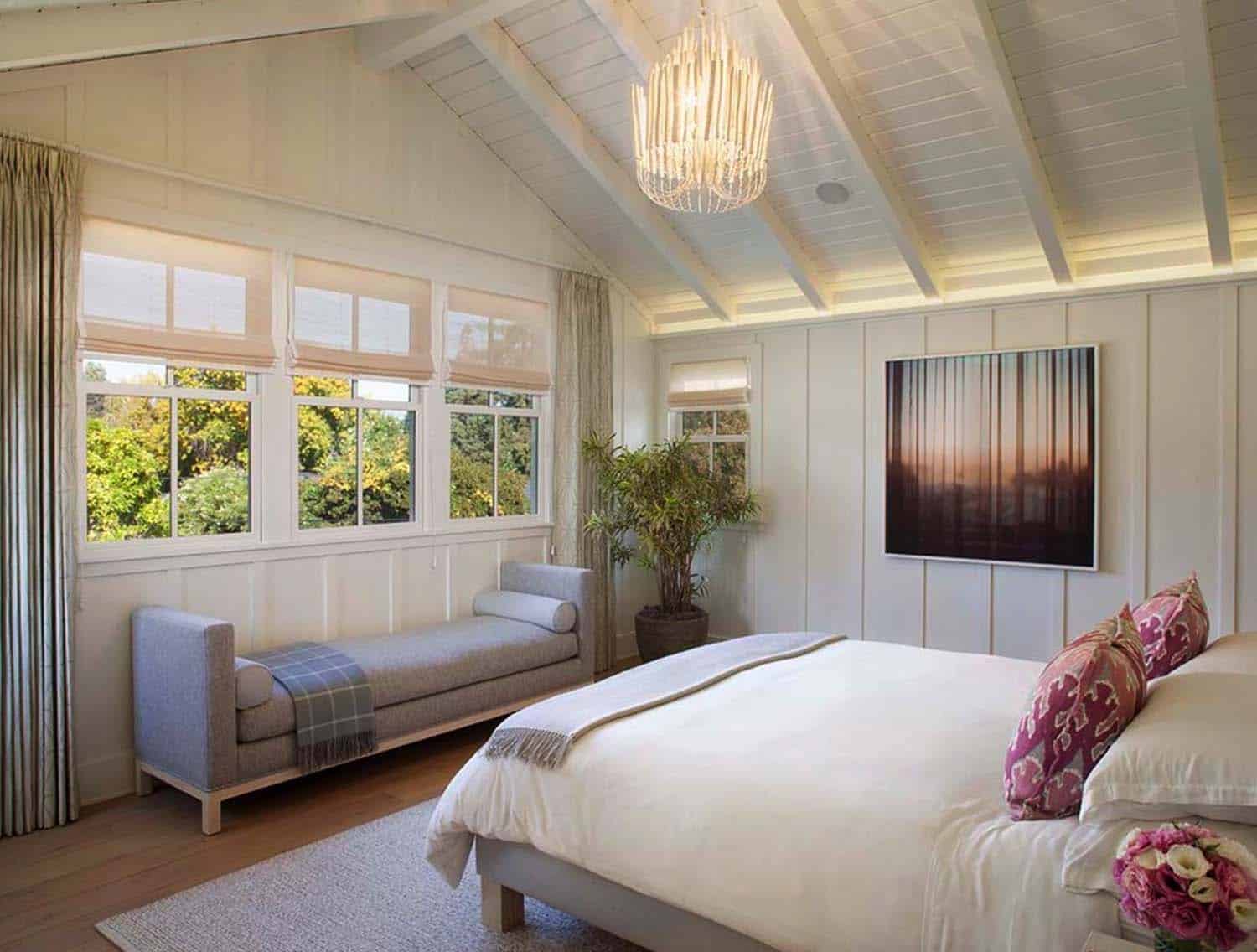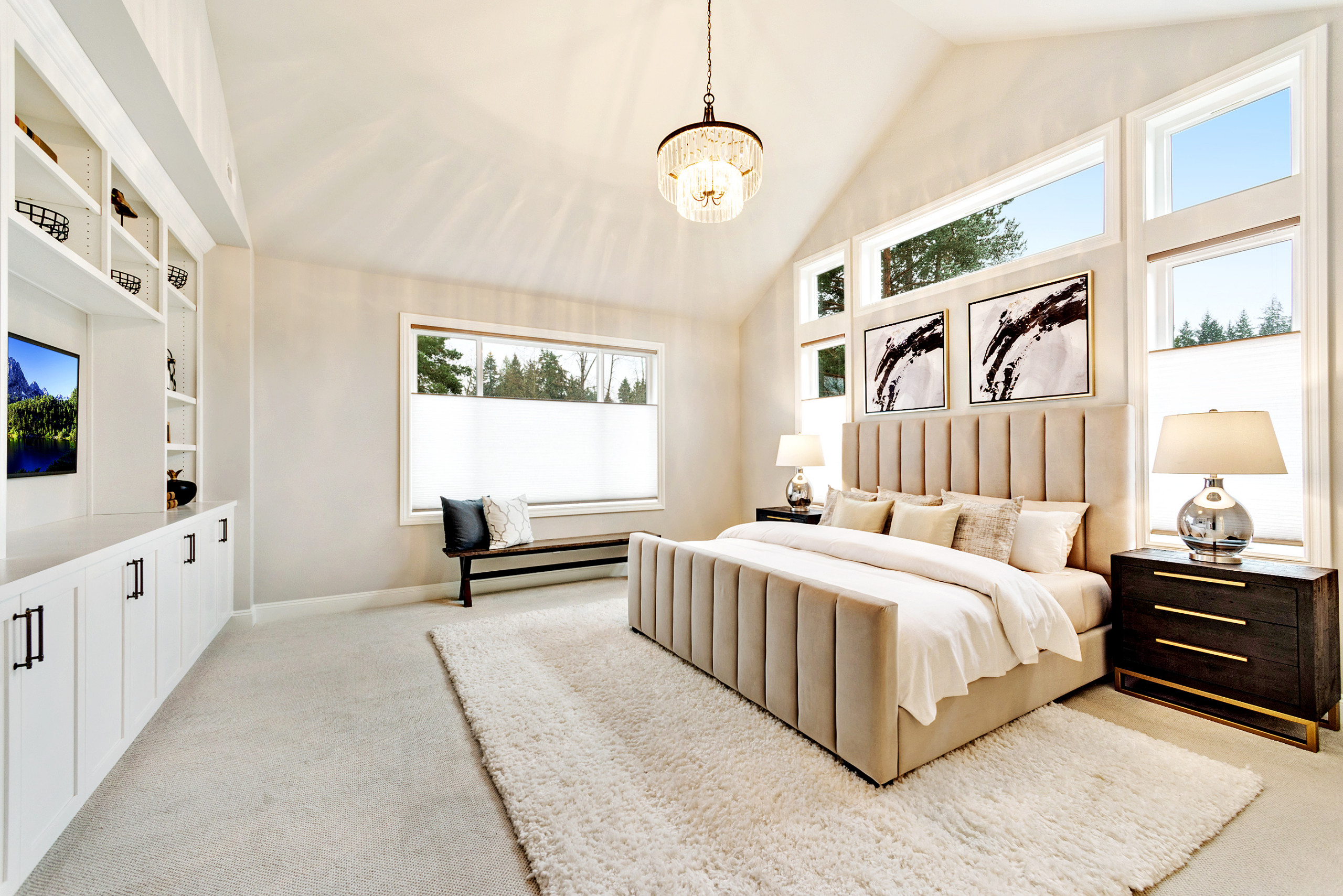The Appeal of Vaulted Ceilings in Master Bedrooms
Vaulted ceilings are a popular architectural feature in master bedrooms, adding a touch of elegance and grandeur to the space. They create a sense of openness and height, making the room feel more spacious and inviting. Beyond aesthetics, vaulted ceilings offer psychological benefits, contributing to a feeling of calmness and serenity.
The Aesthetic Benefits of Vaulted Ceilings
Vaulted ceilings offer a unique aesthetic appeal, adding character and visual interest to master bedrooms. Their upward curves create a sense of height and depth, making the room feel larger and more dramatic. The open space above also allows for the installation of unique lighting fixtures, such as chandeliers or pendant lights, further enhancing the room’s ambiance.
The Psychological Benefits of Vaulted Ceilings
Vaulted ceilings can have a positive impact on our mood and well-being. The open space above us creates a sense of freedom and expansiveness, promoting a feeling of calmness and serenity. This can be especially beneficial in a master bedroom, where we seek relaxation and rejuvenation after a long day.
The Impact of Vaulted Ceilings on Space Perception
Vaulted ceilings can significantly enhance the perception of space in a master bedroom. The vertical lines created by the vaulted ceiling draw the eye upwards, making the room feel taller and more spacious. This is particularly advantageous in smaller bedrooms, where the illusion of greater space can make the room feel more comfortable and welcoming.
Types of Vaulted Ceilings for Master Bedrooms
Vaulted ceilings come in various designs, each offering a unique aesthetic and functional appeal. The most common types include:
- Cathedral ceilings: These ceilings have a steep, pointed arch, often found in traditional homes. They create a dramatic and elegant feel, making the room feel grand and stately.
- Barrel ceilings: These ceilings have a curved, rounded shape, similar to the inside of a barrel. They offer a more modern and contemporary feel, creating a sense of flow and continuity in the room.
- Gable ceilings: These ceilings have a triangular shape, typically found in homes with a pitched roof. They create a cozy and intimate feel, perfect for smaller bedrooms.
- Tray ceilings: These ceilings have a recessed section in the center, creating a layered effect. They add a touch of sophistication and elegance to the room, making it feel more luxurious.
The Suitability of Vaulted Ceilings for Different Bedroom Styles
Vaulted ceilings can complement various bedroom styles, from traditional to contemporary.
- Traditional bedrooms: Cathedral ceilings are a classic choice for traditional bedrooms, adding a touch of grandeur and elegance. The use of ornate moldings and decorative details can further enhance the traditional aesthetic.
- Modern bedrooms: Barrel ceilings or tray ceilings are popular choices for modern bedrooms, creating a sleek and contemporary feel. The use of clean lines and minimalist décor complements the modern aesthetic.
- Rustic bedrooms: Gable ceilings are well-suited for rustic bedrooms, adding a cozy and intimate feel. The use of natural materials, such as wood beams and stone accents, further enhances the rustic aesthetic.
Design Considerations for Vaulted Ceilings: Vaulted Ceiling Master Bedroom

Vaulted ceilings can transform a master bedroom, adding grandeur and a sense of spaciousness. However, incorporating them effectively requires careful planning and consideration of their unique design implications.
Lighting
Lighting plays a crucial role in showcasing the beauty of vaulted ceilings. It can highlight architectural details, create different moods, and influence the overall ambiance of the room.
- Layered Lighting: A combination of ambient, task, and accent lighting is essential for creating a balanced and functional lighting scheme. Ambient lighting provides general illumination, task lighting illuminates specific areas for activities, and accent lighting highlights architectural features or artwork.
- Pendant Lights: These fixtures can be suspended from the vaulted ceiling, adding a touch of elegance and providing focused illumination.
- Recessed Lighting: Recessed lights are discreet and can be used to create a uniform, even glow across the ceiling.
- Sconces: Wall-mounted sconces provide soft, ambient light and can be used to create a warm and inviting atmosphere.
Ventilation
Vaulted ceilings can create challenges for ventilation, as the higher ceilings can trap heat and make the room feel stuffy.
- Ceiling Fans: Ceiling fans are essential for circulating air and keeping the room cool. They can be decorative and functional, adding to the aesthetic appeal of the vaulted ceiling.
- Window Placement: Strategic placement of windows can enhance natural ventilation and create a sense of openness.
- Ventilation Systems: In some cases, installing a whole-house ventilation system can be beneficial, especially in areas with high humidity or extreme temperatures.
Acoustics
Vaulted ceilings can create a sense of spaciousness, but they can also amplify sound, making the room feel echoey.
- Sound-Absorbing Materials: Using materials like carpets, rugs, curtains, and acoustic panels can help absorb sound and reduce reverberation.
- Furniture Placement: Strategic placement of furniture can help break up sound waves and reduce echoes.
- Ceiling Treatments: Acoustic ceiling tiles or panels can be incorporated into the vaulted ceiling design to minimize sound reflection.
Materials and Finishes
The choice of materials and finishes for a vaulted ceiling can significantly impact the overall look and feel of the master bedroom.
- Wood: Wood is a classic and elegant choice for vaulted ceilings, offering warmth and character. It can be stained or painted to complement the overall design scheme.
- Drywall: Drywall is a versatile and affordable option, offering a smooth and clean finish. It can be painted in any color or texture to match the desired aesthetic.
- Stone: Stone adds a rustic and sophisticated touch, creating a unique and visually striking feature.
- Metal: Metal can be used for a modern and industrial look, adding a touch of contemporary flair.
Furniture, Vaulted ceiling master bedroom
Choosing the right furniture for a master bedroom with vaulted ceilings is essential for creating a cohesive and balanced design.
- Scale and Proportion: Furniture should be chosen in a scale that complements the height of the vaulted ceiling. Oversized furniture can overwhelm the space, while small furniture can get lost in the vastness.
- Verticality: Tall furniture, such as armoires, dressers, or bookshelves, can help draw the eye upward and accentuate the height of the vaulted ceiling.
- Lighting: Consider furniture with built-in lighting, such as bedside lamps with adjustable arms, to provide functional and decorative illumination.
Realizing the Vaulted Ceiling Dream

Transforming your master bedroom into a sanctuary of grandeur and spaciousness requires careful planning and execution. Vaulted ceilings offer a unique opportunity to create a dramatic and airy atmosphere, but realizing this dream necessitates a thoughtful approach to design and construction.
The Design and Construction Process
The journey to a vaulted ceiling starts with a clear vision and meticulous planning. Understanding the existing structure and desired aesthetic is crucial. Architectural drawings and structural engineers play a vital role in determining the feasibility and safety of the project. Here’s a step-by-step breakdown of the process:
- Architectural Design: Collaborate with an architect to create detailed plans that incorporate the vaulted ceiling design, considering the existing roof structure, desired ceiling height, and overall aesthetic.
- Structural Engineering: A structural engineer assesses the existing foundation and framing to ensure it can support the additional weight of the vaulted ceiling. They may recommend reinforcement or modifications to the existing structure.
- Material Selection: Choose materials for the vaulted ceiling, considering factors such as budget, desired aesthetic, and durability. Common materials include wood beams, drywall, and plaster.
- Construction: Experienced contractors will meticulously construct the vaulted ceiling, adhering to the architectural and engineering plans. This involves framing, insulation, drywall installation, and finishing touches.
Costs Associated with Vaulted Ceilings
The cost of constructing a vaulted ceiling varies widely depending on factors such as the size of the bedroom, the complexity of the design, the materials used, and the labor costs in your region. Here’s a breakdown of potential costs:
- Architectural and Engineering Fees: These fees cover the design and structural analysis of the vaulted ceiling. Expect to pay between $1,000 to $5,000 depending on the complexity of the project.
- Materials: The cost of materials, such as wood beams, drywall, insulation, and finishing materials, will vary based on your choices. Plan for a budget of $5 to $20 per square foot for materials.
- Labor Costs: Labor costs will depend on the complexity of the construction, the size of the vaulted ceiling, and the availability of skilled labor in your area. Expect to pay between $20 to $50 per square foot for labor.
- Other Costs: Additional costs may include permits, inspections, and any necessary modifications to existing plumbing, electrical, or HVAC systems.
Structural Considerations
Before embarking on a vaulted ceiling project, it’s essential to address potential structural considerations:
- Foundation and Framing: The existing foundation and framing must be able to support the additional weight of the vaulted ceiling. Structural engineers can assess the load-bearing capacity of the structure and recommend any necessary reinforcements.
- Roof Structure: The existing roof structure must be compatible with the vaulted ceiling design. Modifications to the roof trusses or rafters may be required to accommodate the new ceiling configuration.
- Ventilation: Adequate ventilation is crucial for a vaulted ceiling to prevent moisture buildup and maintain a comfortable temperature. Consider incorporating vents or fans to ensure proper airflow.
Inspirational Examples
To spark your imagination, here are examples of master bedrooms with vaulted ceilings that showcase unique design elements:
- Rustic Elegance: A master bedroom with a vaulted ceiling featuring exposed wooden beams and a stone fireplace creates a cozy and inviting atmosphere. The natural wood tones complement the stonework, adding warmth and rustic charm.
- Modern Minimalism: A sleek and minimalist master bedroom with a vaulted ceiling and clean lines emphasizes simplicity and functionality. The high ceiling creates a sense of spaciousness, while the minimalist décor allows the architectural features to take center stage.
- Mediterranean Charm: A master bedroom with a vaulted ceiling inspired by Mediterranean architecture features arched windows, terracotta tile flooring, and whitewashed walls. The arched ceiling adds a touch of elegance and creates a sense of grandeur.
